So there has been a lot of talk that For Honor is a perfect example of how to do female armor. Perhaps the best part about disagreeing with this was it meant a bunch of people who follow for unhelpful reasons ended up agreeing with their nemesis, Kotaku, but the second best part is it let me talk about design and signalling.
Disclaimer
For the people rushing to point out that in 50% of the classes the designs are mostly identical across genders and I agree that’s a pretty good. We also tag For Honor as a positive example.
However, that doesn’t mean it doesn’t have flaws and that it’s better to talk about them rather than just rubberstamp it as flawless.
Also I feel it’s important to point out that there’s literally nothing in For Honor that suggests that historical accuracy was even faintly a priority. The designs are mishmash of various elements of history and fantasy based off what the developers thought looked cool. Therefore any arguments about obscure theories in history or archaic standards are pretty much irrelevant.
– wincenworks
Default and Deviation from Default
As Lindsay Ellis pointed out in her Smurfette Principle video, media has a long obsession with presenting men as the Default and women as the Deviation from Default. You can see this pretty clearly if you assess the Samurai outfits and look for trends.
The classes available male samurai have:
- Expressive masks (2 with helmets, 1 with a decorative topknot)
- High profile breastplates
- Skirt/fauld plating
The female only class has:
- A blank mask with a generic reed hat
- A robe folded to remind you there’s cleavage underneath
- No plating around the waist (just the shoulders)
This visual language immediately tells the audience that the Nobushi (a term invented for the game) exists outside the Samurai standard classes, one of these things is not like the others, one of these things just doesn’t belong.
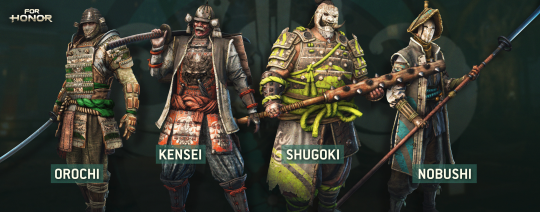
This is also evident when you look at the female raider that her outfit was originally designed with only a male character:
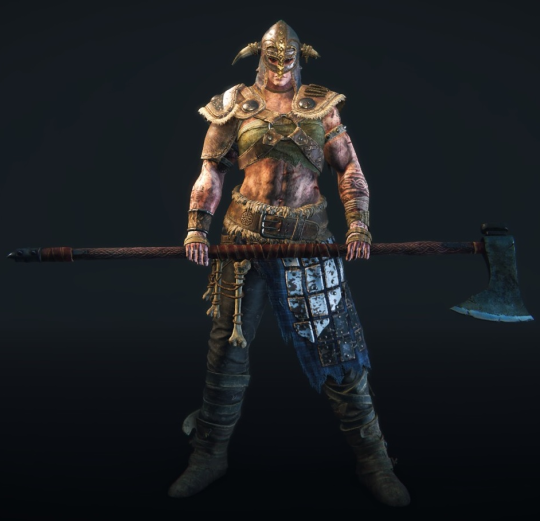
Now, there is an argument going around that this shows they couldn’t have bare breasts because too many vendors would have issues with that, and that this outfit is better than a gold bikini top – that is true.
However, Ubisoft knew that they wouldn’t be able to show bare female breasts from the start – so really what this showcases is that they didn’t consider female characters until they got to a point where their best solution was “just glue some fabric over them” (good luck being impressed by her pecs).
Design Priorities
So every faction has two classes that are available to all genders, one male class and one female class. The general trend is that the male class will fit a conventional warrior mode and the female class will be a designed with a different set of priorities in mind, in the Vikings this is particularly obvious when you consider the Valkyries:
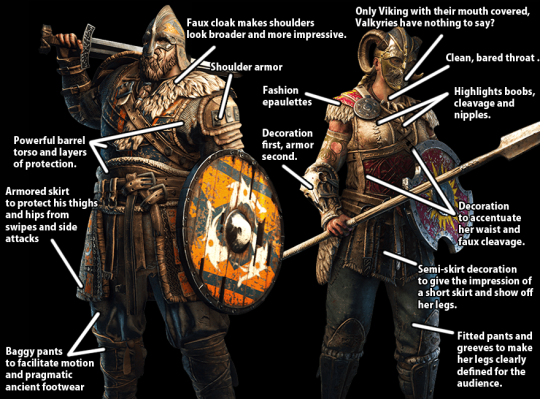
This is also particularly prevalent in the Knights when you consider that their core class (the Wardens) get their armor talked up in a cutscene – making their layered metal armor a defining trait. Knights love their formidable steel armor so much they put steel armor in their steel armor.
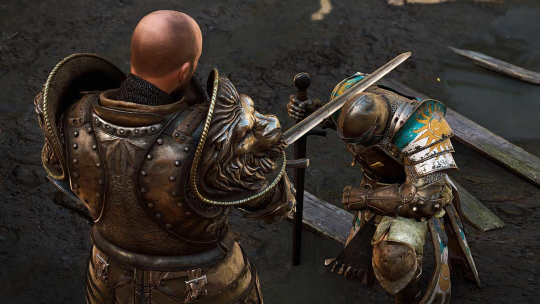
Except for the ladies-only Peacekeepers who only seem to use steel for their masks, greeves and the pushup bras to ensure they have a rounded bust under their organic armor.

Now, if you think this is being picky I assure you that this is generous compared to what would be expected of any professional art director. And Ubisoft is a massive AAA studio who expects those assets to look realistic in HD.
You vs The World
So, with those six classes where you can pick your gender, and the option to change your skin tone (in the classes where you will get to see skin) are still held up as a fix for many of the issues. (In the same way people proposed that Saints Row 4 fixed everything with letting you create a wide range of characters then recreate your character at any point).
The problem with this is if you look at everything For Honor pitches at the world it promotes that the default hero in this game is a light skinned man in a world of light skinned men with a few light skinned women.
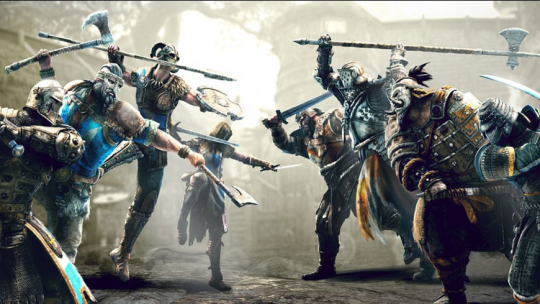
What this means is any time you select a woman in the classes where that is an option, or you change the skin tone of your character to something distinctly darker – your choice is the not an act of selecting your place in the game’s world, rather it’s an act of individual rebellion: using the mechanics of the game to oppose the fluff of the game. (Not entirely unlike when you make an impossibly ugly PC in games with conventional character creators and offer a variety of conventionally attractive faces as default, or may a virtuous hero throw bottles at random people).
Conclusion
Ultimately what this means is that while For Honor allows a wide variety of people to represent themselves (cosmetically) in the game, it’s still not signalling to the world that is actually “for everyone”
Rather, it’s signalling that it’s primarily for light skinned cis men, secondly for light skinned cis women and then has options for people of color with brown skin. The reason it’s getting so much celebration is because this is, sadly, a lot more consideration than is generally given.
For Honor, like Overwatch, is not being celebrated because it has exception equitable designs (particularly compared to say Dark Souls) and inclusion – but rather because the bar for inclusion in high profile media like AAA games is so low that it should be embarrassing not to easily clear it.
– wincenworks
P.S. If you’re a giant budget developer who is planning to distribute your media to millions of people then you should also look not just to make sure you’re not just setting a default and deviation, but also that you’re not inadvertently reinforcing certain unfortunate stereotypes.
